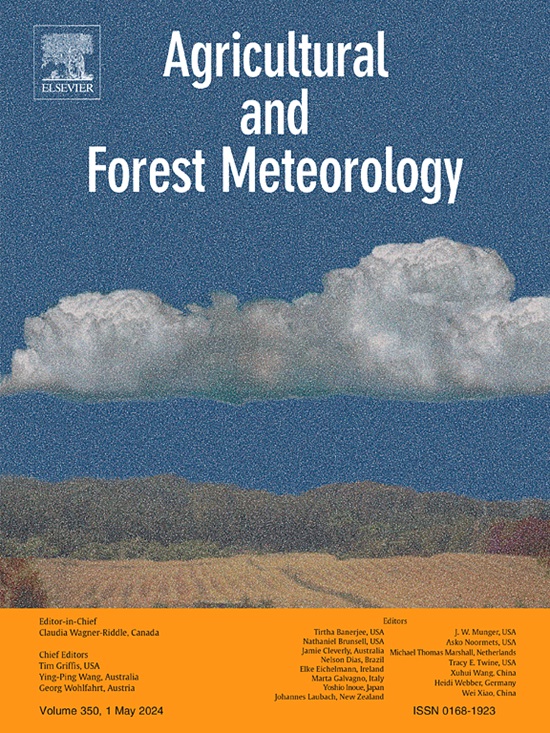气候变化下的暖冬将重塑加拿大东部冬季地下排水模式
IF 5.7
1区 农林科学
Q1 AGRONOMY
引用次数: 0
摘要
地下排水是加拿大东部农田水分和养分流失的主要途径。冬季是寒冷气候下地下排水和养分流失的主要时期。然而,在气候变化的情况下,由于积雪和土壤冻结的减少,未来冬季排水模式可能会发生显著变化。本研究评估了四种机器学习(ML)模型在模拟加拿大东部五个地点冬季地下排水中的性能。然后将校准/训练的ML模型应用于预测1950 - 2100年的未来气候(高排放情景:RCP8.5),以了解全球变暖下冬季排水模式的潜在变化。在ML模型中,Cubist和SVM-RBF模型是最准确的,与计算需求较低的RZ-SHAW模型相比,它们提供了具有竞争力的短期模拟(≤7年)能力。然而,ML模型在气候变化情景下的长期预测显示,由于观测到的冬季地下排水数据不足和不平衡,结果不一致。RZ-SHAW和ML模式的模拟预测,到21世纪末(1950-2005年与2070-2100年相比)冬季径流量将显著增加(RZ-SHAW: 243 mm至328 mm (+ 35%);ML型号:250毫米至425毫米(+ 70%))。从基线到本世纪末,RZ-SHAW模拟了整个冬季向更均匀分布的排水模式的转变。这种变化是由模拟的积雪覆盖期缩短、融雪时间提前和土壤冻结天数减少所驱动的。因此,预计冬季排水高峰和低谷的时间将发生逆转,到本世纪末,2月将成为高峰月份,4月将是最低月份。本文章由计算机程序翻译,如有差异,请以英文原文为准。
Warmer winter under climate change would reshape the winter subsurface drainage pattern in Eastern Canada
Subsurface drainage is a key loss pathway for water and nutrients from agricultural land in Eastern Canada. Winter is a dominant period of subsurface drainage and nutrient loss in cold climates. Under climate change, however, future winter drainage patterns may change significantly due to reductions in snow cover and soil freezing. This study evaluated the performance of four machine-learning (ML) models in simulating winter subsurface drainage for five sites in Eastern Canada. The calibrated/trained ML models were then applied to predicted future climate (high emission scenario: RCP8.5) from 1950 to 2100 to comprehend the potential alteration in winter drainage patterns under global warming. Among ML models, the Cubist and SVM-RBF models emerged as the most accurate, offering competing short-term simulation (≤7 years) capabilities compared to the RZ-SHAW model with lower computational demand. However, ML models’ long-term projections under climate change scenarios revealed inconsistencies from insufficient and unbalanced observed winter subsurface drainage data. Simulation by both the RZ-SHAW and ML models predict a significant increase in winter drainage volume by the end of the 21st century (1950–2005 vs. 2070–2100) (RZ-SHAW: 243 mm to 328 mm (+35 %); ML models: 250 mm to 425 mm (+70 %)). RZ-SHAW simulated a shift towards a more evenly spread drainage pattern throughout the winter months from baseline to the end of the century. This shift was driven by the simulated shorter snow coverage periods, advancement of snowmelt timing, and fewer days of freezing soil. Thus, the timing of peak and trough winter drainage is expected to reverse, with February becoming the peak month and April the lowest by the century's end.
求助全文
通过发布文献求助,成功后即可免费获取论文全文。
去求助
来源期刊
CiteScore
10.30
自引率
9.70%
发文量
415
审稿时长
69 days
期刊介绍:
Agricultural and Forest Meteorology is an international journal for the publication of original articles and reviews on the inter-relationship between meteorology, agriculture, forestry, and natural ecosystems. Emphasis is on basic and applied scientific research relevant to practical problems in the field of plant and soil sciences, ecology and biogeochemistry as affected by weather as well as climate variability and change. Theoretical models should be tested against experimental data. Articles must appeal to an international audience. Special issues devoted to single topics are also published.
Typical topics include canopy micrometeorology (e.g. canopy radiation transfer, turbulence near the ground, evapotranspiration, energy balance, fluxes of trace gases), micrometeorological instrumentation (e.g., sensors for trace gases, flux measurement instruments, radiation measurement techniques), aerobiology (e.g. the dispersion of pollen, spores, insects and pesticides), biometeorology (e.g. the effect of weather and climate on plant distribution, crop yield, water-use efficiency, and plant phenology), forest-fire/weather interactions, and feedbacks from vegetation to weather and the climate system.

 求助内容:
求助内容: 应助结果提醒方式:
应助结果提醒方式:


